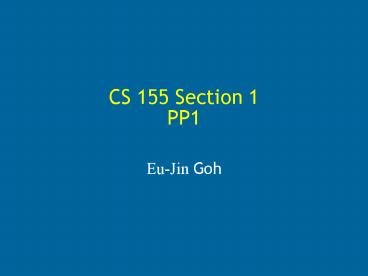CS 155 Section 1 PP1 - PowerPoint PPT Presentation
Title:
CS 155 Section 1 PP1
Description:
Push ebp : saves previous frame pointer. Copy sp into fp : ebp = esp. The new AR's frame pointer will be the previous value of the stack pointer ... – PowerPoint PPT presentation
Number of Views:59
Avg rating:3.0/5.0
Title: CS 155 Section 1 PP1
1
CS 155 Section 1PP1
- Eu-Jin Goh
2
Setting up Environment
- Demo
3
target1.c
- int foo( char arg, char out )
- strcpy( out, arg )
- return 0
- int main( int argc, char argv )
- char buf64
- if ( argc ! 2 )
- foo( argv1, buf )
- return 0
4
Stack in target1 layout
- argv1 ltshellcode bufs addygt
- argv0 /tmp/target1
- argc
- ra to which main() will return
- fp for mains stack frame
- buf64
- ptr to buf out // args to foo()
- ptr to argv1 arg // args to foo()
5
sploit1
- Need
- Location of return address
- addr on stack for ra to overwrite
- need main()s ra (not foo()s)
- Address of the buffer (buf in target1)
- address we want to force the program to jump to
- Distance between buffer and ra
- Size of overflow buffer
6
Buf addr
- addr of the target1 buf depends exploit overflow
buffer size - since exploit string lives above target1 buf on
stack - Once exploit buffer buf fixed, addr of target1
buf wont change.
7
Details
- Size of overflow buffer
- Buf addr 0x9ffffb80
- reg ebp 0x9ffffbc8
- Difference is 0x48 72
- Buffer size 72 4 4 1 81
- Addr of buf
- Buf 0x9ffffe60
8
Crafting the exploit string
- Want target to jump to start of buf,
- place shellcode (size 45 bytes) at the start of
the string - ra exists at offset 76
- need exploit string76 to contain the addr
target1 buf (0x9ffffe60)
9
Hints
- Various ways of seizing program flow control
without overwriting return address - Learn what registers esp, ebp point to during
stages of program execution - Learn what happens to registers and memory during
LEAVE and RET calls
10
IA-32 review
- esp Stack Pointer (SP) points to the top of
the stack (lowest mem addy) - Points to last used word in stack or next
available word location on stack (implementation
dependent) - ebp Frame Pointer (FP) points to fixed
location within an activation record (stack
frame) - If ebp for some stack frame is stored at addr X
then eip for that frame is stored at addr X 4 - Used to reference local vars and parameters since
the distance from those to the frame pointer will
not change whereas the distance from those to the
stack pointer will (as other functions are called
and the stack pointer is decremd ) - eip instruction pointer (aka ra)
- The instruction pointer (EIP) register contains
the offset in the current code segment for the
next instruction to be executed.
11
More IA-32 review
- When CALL procedure p(),
- Push eip the return address (ra)
- Push ebp saves previous frame pointer
- Copy sp into fp ebp esp
- The new ARs frame pointer will be the previous
value of the stack pointer - Advance sp (esp) for allocations on stack (that
is, decrement it) - When LEAVE procedure p(),
- This process is reversed
- Load ebp into esp
- Restore ebp from the stack
12
Interaction between EIP, EBP, ESP
- During CALL, value of eip register pushed onto
stack - Before RET, programmer should make sure that
stack pointer (esp) is pointing to the eip on the
stack does this via - Move contents of ebp into esp
- Increment esp by 4
- esp should now point to (contain addy of) eip
- RET will load the value stored in esp into the
eip register then jump to that value
13
The stack
- 0x9ffffef8 0x9fffff9e argv1 f9e
SHELLCODE - 0x9ffffef4 0x9fffff91 argv0 f91
"/tmp/target1" - 0x9ffffef0 2 argc
- ltSNIPgt
- 0x9ffffeb8 0x9fffff00 lt--- argv1 f00
points to NULL - 0x9ffffeb4 0x9ffffef4 lt--- argv0 ef4
points to f91 - 0x9ffffeb0 2 lt--- argc
- 0x9ffffeac __libc_start_main198 lt--- ra
what we want to overwrite - 0x9ffffea8 0x9ffffec8 lt--- fp frame
pointer - 0x9ffffea4 0x9ffffef4 lt--- argv0 ef4
points to f91 - 0x9ffffea0 _rtld_global lt--- garbage
alignment stuff? - 0x9ffffe9c ------last word of buf------
- ltSNIPgt
- 0x9ffffe60 ------beginning of buf------
- 0x9ffffe5c
- 0x9ffffe58
- 0x9ffffe54 0x9ffffe60 argv1 lt-- points to
beginning of buf - 0x9ffffe50 0x9fffff9e argv0 lt-- points to
shellcode - 0x9ffffe4c 0x8048461 lt--- ra in foo()
ltmain78gt































